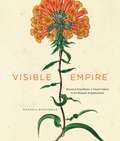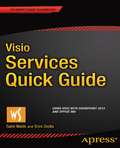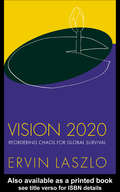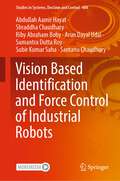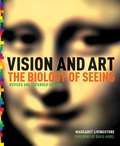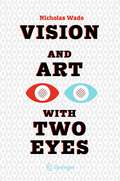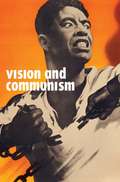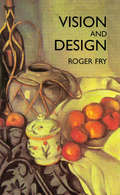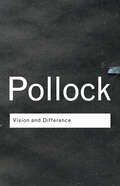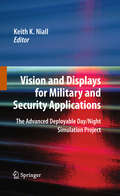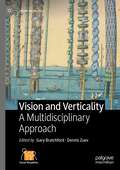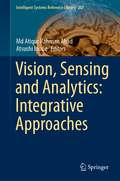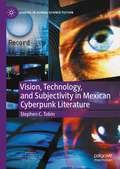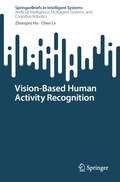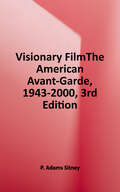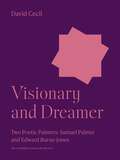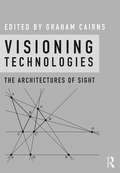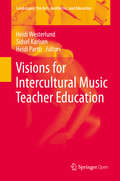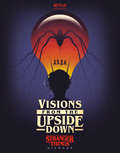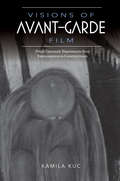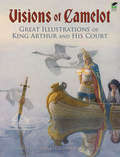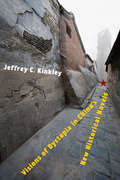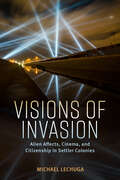- Table View
- List View
Visible Empire: Botanical Expeditions and Visual Culture in the Hispanic Enlightenment
by Daniela BleichmarBetween 1777 and 1816, botanical expeditions crisscrossed the vast Spanish empire in an ambitious project to survey the flora of much of the Americas, the Caribbean, and the Philippines. While these voyages produced written texts and compiled collections of specimens, they dedicated an overwhelming proportion of their resources and energy to the creation of visual materials. European and American naturalists and artists collaborated to manufacture a staggering total of more than 12,000 botanical illustrations. Yet these images have remained largely overlooked—until now. In this lavishly illustrated volume, Daniela Bleichmar gives this archive its due, finding in these botanical images a window into the worlds of Enlightenment science, visual culture, and empire. Through innovative interdisciplinary scholarship that bridges the histories of science, visual culture, and the Hispanic world, Bleichmar uses these images to trace two related histories: the little-known history of scientific expeditions in the Hispanic Enlightenment and the history of visual evidence in both science and administration in the early modern Spanish empire. As Bleichmar shows, in the Spanish empire visual epistemology operated not only in scientific contexts but also as part of an imperial apparatus that had a long-established tradition of deploying visual evidence for administrative purposes.
Visible and Invisible Whiteness: American White Supremacy through the Cinematic Lens
by Alice Mikal CravenVisible and Invisible Whiteness examines the complicity between Classical Hollywood narratives or genres and representations of white supremacy in the cinema. Close readings of D.W. Griffith’s The Birth of a Nation by James Agee and James Baldwin explore these authors’ perspectives on the American mythologies which ground Griffith’s film. The intersectionality of Bordwell’s theories on Classical Hollywood Narrative versus Art Cinema and Richard Dyer’s seminal work on whiteness forms the theoretical base for the book. Featured films are those which have been undervalued or banned due to their hybrid natures with respect to Hollywood and Art Cinema techniques, such as Samuel Fuller’s White Dog and Jean Renoir’s The Southerner. The book offers comparative analyses of American studio-based directors as well as European and European émigrés directors. It appeals to scholars of Film Theory, African American and Whiteness Studies. It provides insight for readers concerned about the re-emergence of white supremacist tensions in contemporary America.
Visio Services Quick Guide
by Sahil Malik Srini SistlaIn this fast-paced 100-page guide, you'll learn to load, display and interact with dynamic, data-powered Visio diagrams in SharePoint 2013 or Office 365. Visio Services Quick Guide gives you the tools to build anything from a simple project workflow to an organizational infrastructure diagram, powered by real data from SharePoint or SQL Server. Colleagues can load your diagrams entirely in the browser, meaning that a single Visio client installation is enough to get started. Readers with JavaScript experience will also find out how to get additional control over Visio diagrams using the JavaScript mashup API, and how to build a custom data provider. The final chapter covers some useful information on administering Visio Services. Get started bringing your Visio diagrams to life with the Visio Services Quick Guide.
Vision 2020: Reordering Chaos For Global Survival
by Ervin LaszloThis revised edition of the classic text of the period provides both the student and the specialist with an informative account of post-Roman English society.
Vision Based Identification and Force Control of Industrial Robots (Studies in Systems, Decision and Control #404)
by Subir Kumar Saha Santanu Chaudhury Abdullah Aamir Hayat Shraddha Chaudhary Riby Abraham Boby Arun Dayal Udai Sumantra Dutta RoyThis book focuses on end-to-end robotic applications using vision and control algorithms, exposing its readers to design innovative solutions towards sensors-guided robotic bin-picking and assembly in an unstructured environment. The use of sensor fusion is demonstrated through a bin-picking task of texture-less cylindrical objects. The system identification techniques are also discussed for obtaining precise kinematic and dynamic parameters of an industrial robot which facilitates the control schemes to perform pick-and-place tasks autonomously without any interference from the user. The uniqueness of this book lies in a judicious balance between theory and technology within the context of industrial application. Therefore, it will be valuable to researchers working in the area of vision- and force control- based robotics, as well as beginners in this inter-disciplinary area, as it deals with the basics and technologically advanced research strategies.
Vision and Art
by Margaret S. Livingstone David Hubel<p>With the original release of Vision and Art in 2002, Harvard professor Margaret Livingstone successfully bridged the gap between science and art, exploring how great painters fool the brain: why Mona Lisa’s smile seems so mysterious, or Monet’s Poppy Field appears to sway. In the revised and expanded edition, Livingstone presents two new chapters of her latest observations, has substantially expanded other chapters, and updates the rest of the existing text with new insights gleaned from her ongoing research, bringing the book to the cutting edge in the field of neuroscience. <p>Accompanying Livingstone’s lively prose are many charts and diagrams that lucidly illustrate her points, as well as in-depth analyses of the phenomena found in major works of art. Be it the explanation of common optical illusions or the breakdown of techniques painters use to create those illusions, Vision and Art provides a wealth of information for artists, scholars, and scientists alike.</p>
Vision and Art with Two Eyes (Vision, Illusion and Perception #3)
by Nicholas WadeThis book celebrates binocular vision by presenting illustrations that require two eyes to see the effects of cooperation and competition between them. Pictures are flat but by printing them in different colours and viewing them through similarly coloured filters (included with the book) they are brought to life either in stereoscopic depth or in rivalry with one another. They are called anaglyphs and all those in the book display the ways in which the eyes interact. Thus, the reader is an integral element in the book and not all readers will see the same things. The history, science and art of binocular vision can be experienced in ways that are not usually available to us and with images made specifically for this book. The study of vision with two eyes was transformed by the invention of stereoscopes in the early 19th century. Anaglyphs are simple forms of stereoscopes that have three possible outcomes from viewing them – with each eye alone to see the monocular images, with both eyes to see them in stereoscopic depth or rivalry, or without the red/cyan glasses where they can have an appeal independent of the binocularity they encompass. Through the binocular pictures and the words that accompany them there will be an appreciation of just how remarkable the processes are that yield binocular singleness and depth. Moreover, the opportunities for expressing these processes are explored with many examples of truly binocular art.
Vision and Communism
by Stephanie Smith Christopher P. Heuer Robert Bird Matthew Jesse Jackson Tumelo MosakaIn the last thirty years of the Soviet Communist project, Viktor Koretsky's art struggled to solve an enduring riddle: how to ensure or restore Communism's moral health through the production of a distinctively Communist vision. In this sense Koretsky's art demonstrates what an "avant-garde late Communist art" would have looked like if we had ever seen it mature. Most striking of all, Koretsky was pioneering the visual languages of Benetton and MTV at a time when the iconography of interracial togetherness was still only a vague rumor on Madison Avenue.Vision and Communism presents a series of interconnected essays devoted to Viktor Koretsky's art and the social worlds that it hoped to transform. Produced collectively by its five editors, this writing also considers the visual art, film, and music included in the exhibition Vision and Communism, opening at the Smart Museum of Art in September 2011.
Vision and Design
by Roger FryTwenty-five art-related essays by distinguished British art critic and painter reveal his wide-ranging interests. Writings explore relationships between ancient and modern art and between art and life, examining such diverse topics as the art of the Bushmen, African sculpture, ancient American art, Giotto and the art of Florence, the paintings of Dürer, El Greco and William Blake, the drawings of Aubrey Beardsley, the works of Paul Cézanne, and contemporary domestic architecture. Also includes Fry's most important theoretical statement, his "Essay in Aesthetics." 13 black-and-white illustrations.
Vision and Difference: Feminism, Femininity and Histories of Art (Routledge Classics Ser.)
by Griselda PollockGriselda Pollock provides concrete historical analyses of key moments in the formation of modern culture to reveal the sexual politics at the heart of modernist art. Crucially, she not only explores a feminist re-reading of the works of canonical male Impressionist and Pre-Raphaelite artists including Edgar Degas and Dante Gabriel Rossetti, but also re-inserts into art history their female contemporaries - women artists such as Berthe Morisot and Mary Cassatt. Pollock discusses the work of women artists such as Mary Kelly and Yve Lomax, highlighting the problems of working in a culture where the feminine is still defined as the object of the male gaze. Now published with a new introduction, Vision and Difference is as powerful as ever for all those seeking not only to understand the history of the feminine in art, but also to develop new strategies for representation for the future.
Vision and Displays for Military and Security Applications
by Keith K. NiallThe book discusses advances in projection technologies used for simulation in military and security applications. More specifically, the subject of this book is using high-resolution projection display technology for simulating night vision device conditions while increasing the distance that objects can be simulated under simulated daylight conditions. Topics covered include: advances in high-resolution projection, advances in image generation, advances in geographic modelling or photogrammetric technologies, night vision goggle human factors research, night vision goggle training techniques. The book will have special features including graphs and systems operational architectural diagrams specific to these domains. The main benefit the reader will gain from this book is that it will present leading edge methods for conducting human factors research for night vision device research, while also presenting leading edge technologies used design and apply visual displays for current simulations.
Vision and Verticality: A Multidisciplinary Approach (Social Visualities)
by Dennis Zuev Gary BratchfordThis rich and accessible volume maps current debates within the expanded field of image-based, vertical analysis. With contributions from astronauts, artists, architects, sociologists, urbanists, visual culture theorists, geographers, anthropologists and more the book signals new moves in inter and multidisciplinary research on visual-vertical thinking and related practices within the social sciences, humanities and across the arts. Grounded in socio-visual thinking, Vision and Verticality addresses the emerging shift in the way social scientists move from a sociology of or through images towards a sociology with images. In doing so, this volume illustrates how the sky and atmosphere remain a surprisingly underexplored domain within visual sociology, beyond the framework of drone-related research. Finally, this volume asserts how vertical and atmospherically framed socio-visual analysis is beginning to shape and inform how we see and experience urban spaces, travel, leisure, politics, and environmental challenges through various prisms, including artistic practices, methodological processes, and user-generated content.
Vision, Sensing and Analytics: Integrative Approaches (Intelligent Systems Reference Library #207)
by Atsushi Inoue Md Atiqur Rahman AhadThis book serves as the first guideline of the integrative approach, optimal for our new and young generations. Recent technology advancements in computer vision, IoT sensors, and analytics open the door to highly impactful innovations and applications as a result of effective and efficient integration of those. Such integration has brought to scientists and engineers a new approach —the integrative approach. This offers far more rapid development and scalable architecting when comparing to the traditional hardcore developmental approach. Featuring biomedical and healthcare challenges including COVID-19, we present a collection of carefully selective cases with significant added- values as a result of integrations, e.g., sensing with AI, analytics with different data sources, and comprehensive monitoring with many different sensors, while sustaining its readability.
Vision, Technology, and Subjectivity in Mexican Cyberpunk Literature (Studies in Global Science Fiction)
by Stephen C. TobinVision, Technology and Subjectivity in Mexican Cyberpunk Literature interrogates an array of cyberpunk and post-cyberpunk science fiction novels and short stories from Mexico whose themes engage directly with visual technologies and the subjectivities they help produce – all published during and influenced by the country’s neoliberal era. This book argues that television, computers, and smartphones and the literary narratives that treat them all correspond to separate-yet-overlapping scopic regimes within the country today. Amidst the shifts occurring in the country’s field of vision during this period, the authors of these cyberpunk and post-cyberpunk narratives imagine how these devices contribute to producing specular subjects—or subjects who are constituted in large measure by their use and interaction with visual technologies. In doing so, they repeatedly recur to the posthuman figure of the cyborg in order to articulate these changes; Stephen C. Tobin therefore contends that the literary cyborg becomes a discursive site for working through the problematics of sight in Mexico during the globalized era. In all, these “specular fictions” represent an exceptional tendency within literary expression—especially within the cyberpunk genre—that grapples with themes and issues regarding the nature of vision being increasingly mediated by technology.
Vision-Based Human Activity Recognition (SpringerBriefs in Intelligent Systems)
by Zhongxu Hu Chen LvThis book offers a systematic, comprehensive, and timely review on V-HAR, and it covers the related tasks, cutting-edge technologies, and applications of V-HAR, especially the deep learning-based approaches. The field of Human Activity Recognition (HAR) has become one of the trendiest research topics due to the availability of various sensors, live streaming of data and the advancement in computer vision, machine learning, etc. HAR can be extensively used in many scenarios, for example, medical diagnosis, video surveillance, public governance, also in human–machine interaction applications. In HAR, various human activities such as walking, running, sitting, sleeping, standing, showering, cooking, driving, abnormal activities, etc., are recognized. The data can be collected from wearable sensors or accelerometer or through video frames or images; among all the sensors, vision-based sensors are now the most widely used sensors due to their low-cost, high-quality, and unintrusive characteristics. Therefore, vision-based human activity recognition (V-HAR) is the most important and commonly used category among all HAR technologies.The addressed topics include hand gestures, head pose, body activity, eye gaze, attention modeling, etc. The latest advancements and the commonly used benchmark are given. Furthermore, this book also discusses the future directions and recommendations for the new researchers.
Visionary Film: The American Avant-Garde, 1943-2000
by P. Adams SitneyCritics hailed previous editions of Visionary Film as the most complete work written on the exciting, often puzzling, and always controversial genre of American avant-garde film. This book has remained the standard text on American avant-garde film since the publication of its first edition in 1974. <p><p>Now P. Adams Sitney has once again revised and updated this classic work, restoring a chapter on the films of Gregory J. Markopoulos and bringing his discussion of the principal genres and major filmmakers up to the year 2000.
Visionary and Dreamer: Two Poetic Painters: Samuel Palmer and Edward Burne-Jones (The A. W. Mellon Lectures in the Fine Arts #15)
by David CecilAn eminent literary biographer and critic shows how poetry enriched the art of two representative English Romantic paintersIn Visionary and Dreamer, David Cecil evokes the century of the poet-painter, when painting drew much of its inspiration from imaginative literature. Samuel Palmer (1805–1881), an unworldly visionary, obscure in his lifetime but now a recognized master, and Edward Burne-Jones (1833–1898), the Pre-Raphaelite daydreamer, once revered as a great painter but later admired chiefly for his work in applied art, emerge as artists who turned to their own inner lives to interpret Shakespeare, Milton, and Keats.
Visioning Technologies: The Architectures of Sight
by Graham CairnsVisioning Technologies brings together a collection of texts from leading theorists to examine how architecture has been, and is, reframed and restructured by the visual and theoretical frameworks introduced by different ‘technologies of sight’ – understood to include orthographic projection, perspective drawing, telescopic devices, photography, film and computer visualization, amongst others. Each chapter deals with its own area and historical period of expertise, organized sequentially to mark out and analyse the historical evolution of how architecture has been transformed by technologically induced shifts in human perception from the 15th century until today. This book underlines the way in which architectural forms and design processes have developed historically in conjunction with the systems of sight we manufacture technologically and suggests this continues today. Paradoxically, it is premised on the argument that these technological systems tend, in their initial formulations, to obtain ever greater realism in our visualizations of the physical world.
Visions for Intercultural Music Teacher Education (Landscapes: the Arts, Aesthetics, and Education #26)
by Heidi Westerlund Sidsel Karlsen Heidi ParttiThis open access book highlights the importance of visions of alternative futures in music teacher education in a time of increasing societal complexity due to increased diversity. There are policies at every level to counter prejudice, increase opportunities, reduce inequalities, stimulate change in educational systems, and prevent and counter polarization. Foregrounding the intimate connections between music, society and education, this book suggests ways that music teacher education might be an arena for the reflexive contestation of traditions, hierarchies, practices and structures. The visions for intercultural music teacher education offered in this book arise from a variety of practical projects, intercultural collaborations, and cross-national work conducted in music teacher education. The chapters open up new horizons for understanding the tension-fields and possible discomfort that music teacher educators face when becoming change agents. They highlight the importance of collaborations, resilience and perseverance when enacting visions on the program level of higher education institutions, and the need for change in re-imagining music teacher education programs.
Visions from the Upside Down: Stranger Things Artbook (Stranger Things)
by NetflixOver 200 artists present their own unique visions of Stranger Things in a stunning celebration of the runaway hit Netflix series. In honor of Stranger Things, the innovative pop culture enthusiasts at Printed In Bloodare proud to present the latest release in their ongoing series of artbooks. More than two hundred artists, drawn from the earthly dimensions of comics, illustration, fine art, videogames, and animation, have come together to bring us a unique vision of the world of Hawkins, Indiana. Come dig into this collection of more than two hundred brand-new images and see what new worlds you might discover lurking just beneath the surface. Includes art by: ORLANDO AROCENA • MATT BUSCH • BUTCHER BILLY • RIAN HUGHES • JOHN McCREA • MATT NEEDLE • GARY PULLIN • BILL SIENKIEWICZ • EILEEN STEINBACH & MORE!This ebook is best viewed on a color device with a larger screen.
Visions of Avant-Garde Film: Polish Cinematic Experiments from Expressionism to Constructivism
by Kamila KucWarsaw- and London-based filmmakers Franciszka and Stefan Themerson are often recognized internationally as pioneers of the 1930s Polish avant-garde. Yet, from the turn of the century to the end of the 1920s, Poland’s literary and art scenes were also producing a rich array of criticism and early experiments with the moving image that set the stage for later developments in the avant-garde. In this comprehensive and accessible study, Kamila Kuc draws on myriad undiscovered archival sources to tell the history of early Polish avant-garde movements—Symbolism, Expressionism, Futurism, and Constructivism—and to reveal their impact on later practices in art cinema.
Visions of Camelot: Great Illustrations of King Arthur and His Court
by Jeff A. MengesEvery generation has a chance to rediscover the ageless tales from Arthurian myth. But who was King Arthur? Was he a great and noble king, a strong warrior chieftain, a Celtic deity, or a compelling character of myth and legend? The lack of solid evidence has fueled fierce debate among scholars and historians. But whether or not we can verify his existence -- or guess at his appearance -- a gallery of important artists have used their prodigious talents to depict King Arthur and his compatriots in a range of creative styles. This stunning array of 148 color and black-and-white illustrations compiles the best of this artwork. This unique collection presents interpretations of medieval times and the chivalric code -- from simply elegant to lavishly ornate -- by legends N. C. Wyeth, Aubrey Beardsley, William Russell Flint, Howard Pyle, and others. Accompanied by an introduction to each artist and his work, this visual feast is a triumph of creativity and a tempting invitation to return to the spellbinding world of Camelot.
Visions of Dystopia in China's New Historical Novels
by Jeffrey C. KinkleyThe epic narratives of modern Chinese fiction feature graphic depictions of sex and violence and dark, raunchy comedy, and these novels deeply reflect China's turbulent recent history
Visions of Invasion: Alien Affects, Cinema, and Citizenship in Settler Colonies (Race, Rhetoric, and Media Series)
by Michael LechugaVisions of Invasion: Alien Affects, Cinema, and Citizenship in Settler Colonies explores how the US government mobilizes media and surveillance technologies to operate a highly networked, multidimensional system for controlling migrants. Author Michael Lechuga focuses on three arenas where a citizenship control assemblage manufactures alienhood: Hollywood extraterrestrial invasion film, federal antimigration and border security legislation, and various immigration enforcement protocols implemented along the Mexico–United States border. Building on rhetorical studies, settler colonial studies, and media studies, Visions of Invasion offers a glimpse at how the processes of alien-making contribute to an ongoing settler colonial project in the US. Lechuga demonstrates that popular films—The War of the Worlds, Predator, Men in Black, and more—participate in the production of migrants as subjective terrorists, felons, and other noncitizen personae vilified in public discourse. Beyond just tracing how alien invasion narratives circulate in popular media, Lechuga describes how the logics motivating early US colonists materialize in both the US’s citizenship control policy and in some of the country’s most popular texts. Beneath each of the film franchises and antimigrant political expressions described in Visions of Invasion lies an anxious colonial logic in which the settler way of life is seemingly threated by false narratives of imminent invasion from abroad. The volume offers a deep dive into how the rhetorical figure of the alien has been manufactured as a political subjectivity, one that plays out the anxieties, guilts, and fears of colonialism in today’s science fiction landscape.
Visions of Japanese Modernity: Articulations of Cinema, Nation, and Spectatorship, 1895-1925
by Aaron GerowGerow explores the processes by which film was defined, transformed, and adapted during its first three decades in Japan. He focuses in particular on how one trend in criticism, the Pure Film Movement, changed not only the way films were made, but also how they were conceived.
